 This is the second of a two-part series (see part one) on the structure of the voting process, as carried out in Harris County (near Houston), Texas. Where previously we addressed the geography linking neighborhood precincts, election districts and voters, this article is about…
This is the second of a two-part series (see part one) on the structure of the voting process, as carried out in Harris County (near Houston), Texas. Where previously we addressed the geography linking neighborhood precincts, election districts and voters, this article is about…
Voter Registrations – How each potential voter is recorded and connected to a precinct
Candidacies – How a candidate for an office (or a ballot measure) may be shown relative to the district he or she (or it) represents.
Elections – How ballots are selectively defined for each precinct.
Voting Sessions – How a vote may be recorded for each candidate (or ballot measure).
Voter Registration
Voter registration is a county’s (in this case, Harris County’s) grant of a person’s right to vote in a specific precinct. Figure 1 shows the form used in Harris county for registering someone. The first part establishes that the person is a Citizen of the United States and if ‘e is old enough to vote.
The next part is where the applicant records h’ name and residence address. The applicant may also include a “Mailing Address” but that’s only for purposes of receiving the registration card. Note that the address includes specifying the county. If it is not “Harris”, the form will require special processing.
The middle of the form includes Birthday, plus (optionally) the Gender and Telephone Number of the applicant. The next line is not strictly required for registration, but when the voter presents h’ self to vote, a picture ID, such as a driver’s license will be required (unless ‘e signs an affidavit that one cannot be obtained). For purposes of completeness, the last four digits of one’s social security number may also be specified here.
Finally, the prospective voter signs and dates the form, agreeing to the conditions shown.
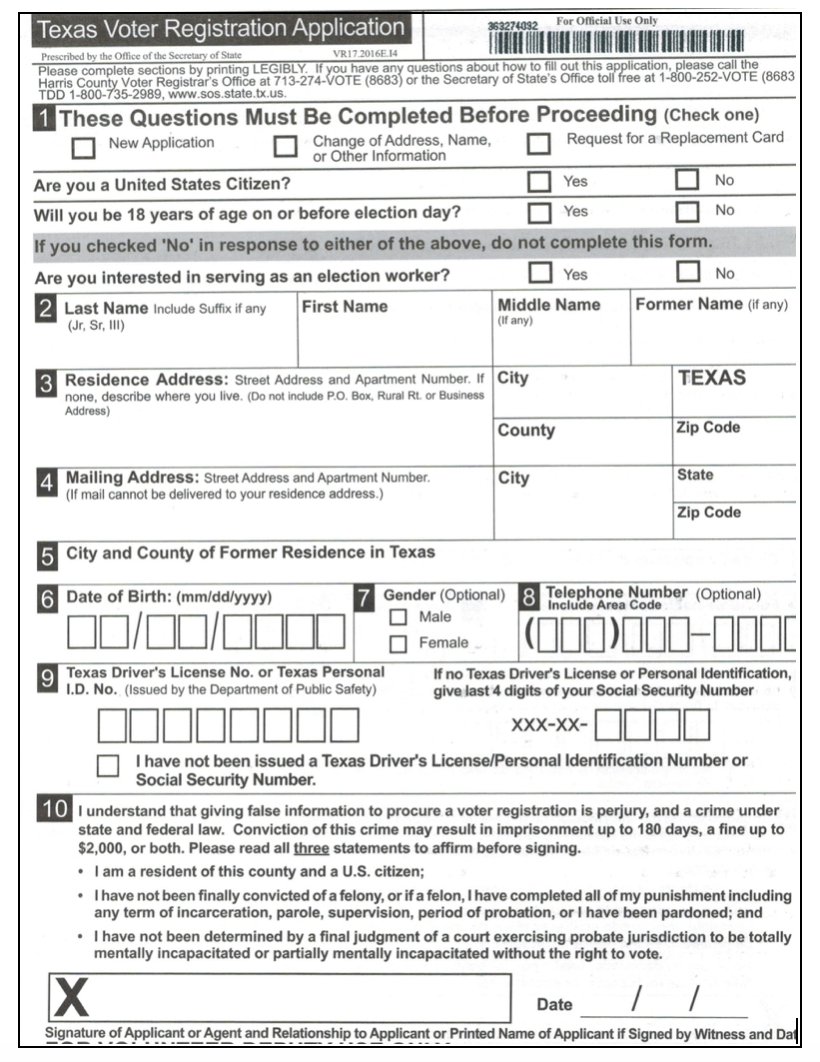
Figure 1: Voter Registration Form
Figure 2 adds the entity type voter registration to our model. As shown in the Figure, each voter registration must be held by only one person and must be for one and only one residence address (or an apartment in such a residence address). The person involved is here represented by a separate entity type, with the attributes “First Name”, “Last Name”, “Date Of Birth”, “Telephone Number”, etc.
Note that mandatory attributes of voter registration are “Registration Number” (shown in the upper right corner of the form) and “Approval Date”.
Business Rule: A voter registration may not be officially entered until it has been approved by the Secretary of State’s office.
(The sort of staging files that may be of use here are not represented in this model.)

Figure 2: Voter Registration
A precinct is basically defined by its boundaries, but when a request for a voter registration appears, it is necessary to use the voter’s mailing address to identify the precinct that the ‘e belongs to. To do this association, a precinct street segment is found that corresponds to the “house number” and “street” of the residence address. (See the above section beginning on page Error! Bookmark not defined.) The found precinct street segment, in turn, is to define the precinct (or sub–precinct) that is therefore (indirectly) the location of the voter registration.
Once a voter registration has been accepted, a certificate is sent out to the voter that looks like Figure 3. Note that the Voter “Name” and ”Residence Address” are shown, along with various identifying numbers and the voter’s “Birth Year”. More significant is the “Precinct Number”. Following the logic described earlier in this paper, the voter registration certificate also includes the:
- S. REP(…resentative District)
- STATE SEN(…ate District)
- STATE REP(…resentative District)
- COMM(…issioner’s) PCT (Precinct)
- J(…ustice of the) P(eace)
Also shown is the “CITY” and the “SCHOOL( District)” where the precinct is located.
Finally, the “Mailing Address” to where the certificate will be mailed.
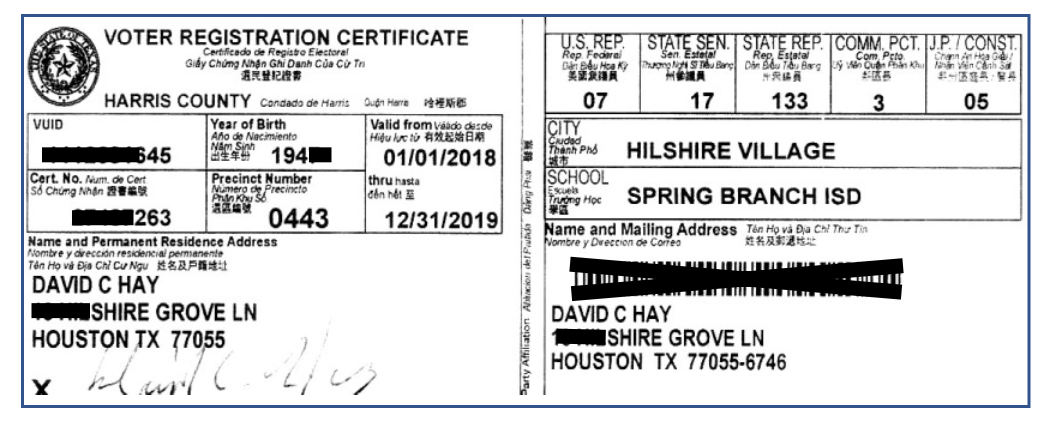
Figure 3: Voter Registration Card
Once a person has registered to vote, the registration is valid until ‘e moves.
Candidacies
One precinct structure (about, for example, precinct 0443 – “The City of Hilshire Village”) could be a reference to one state (in this case, “Texas”). Another precinct structure for precinct 0443 could be a reference to one us congressional district (such as “Us Congressional District 7”) up to this point, the model has been relatively static (although the set of registrations ebbs and flows.) In 2018, however, the county and state undertook an election that entailed each individual geopolitical location being engaged in an election for one or more positions, such as “Governor”, or “Congressional Representative”. The geopolitical area may also be the object of one or more measures, where a measure could be a bond issue or a state constitutional amendment. Each measure may be evaluated with one of two possible results (“yes” or “no”). This is shown in Figure 4.
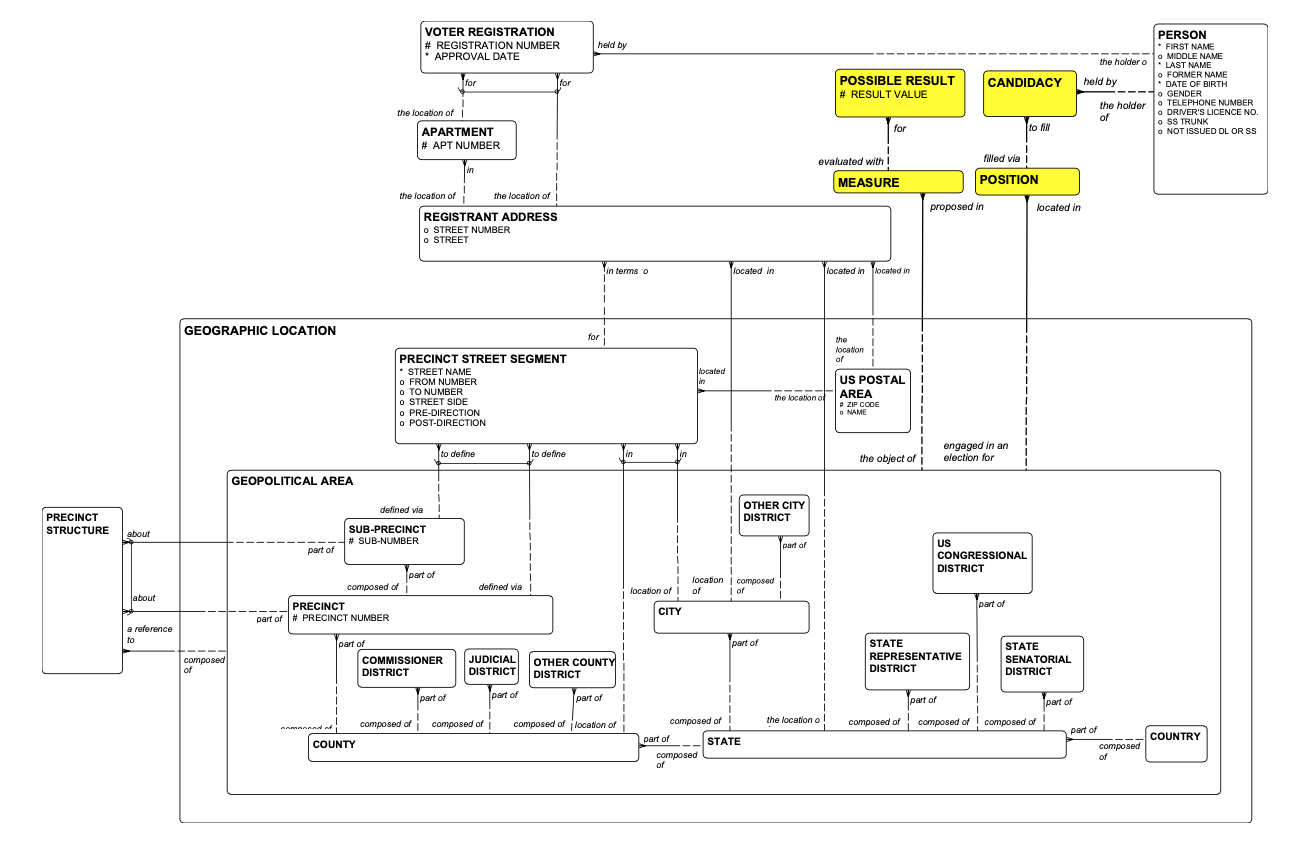
Figure 4: Positions and Candidacies
On November 6, 2018, one of these (the state of “Texas”) was engaged in an election for the position “United States Senator”, which was filled via three candidacies. Of these candidacies, one was held by a person (Republican), “Ted Cruz”; another one was held by a person (Democrat), “Beto O’Rourke”; a third one was held by a person (Libertarian), “Neal M. Dikeman”.
A second precinct structure (again, about precinct 0443) is a reference to a US congressional district (7), which was (as of November 6, 2018) engaged in an election for “Congressional Representative”. Of the current candidacies that were to fill that position one was held by a person (Democrat) “Lizzie Fletcher”, and one was held by a person (Republican) “John Culberson”.
In November 2018, there were no instances in precinct 0445 of measures.
Elections
Figure 5 introduces the entity type election. This is the formal process by which citizens determine who will hold important offices in city, county, state and national governments. Elections are held a few times in most years. Specifically, every other year there are one or more “primary” elections along with one “general” election. At various other times, there may also be one or more “local” elections, such as for bond issues. Each election, then, is uniquely identified by a combination of the attributes “election year”, “election type” (“primary”, “general”, or other), and “official date”. Optionally, other attributes may include “first early date”, and “last early date”.
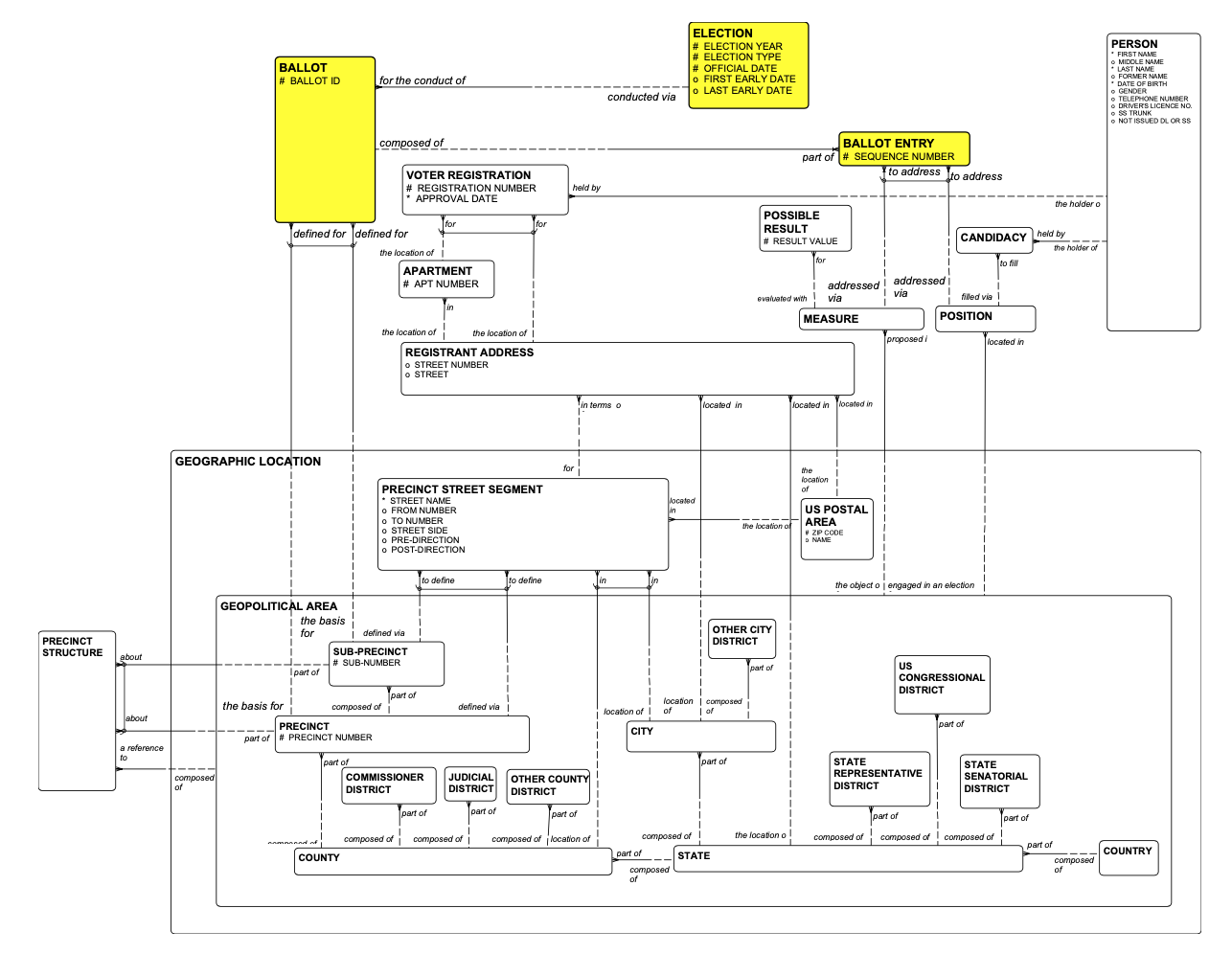
Figure 5: Elections and Ballots
Each election may be conducted via a collection of one or more ballots, where each ballot must be for the conduct of one and only one election and must be defined for one and only one precinct (or sub–precinct). Each ballot, in turn may be composed of one or more ballot entries, where each ballot entry must be either to address one and only one position or to address one and only one measure.
Business rule: Each ballot entry that is part of a particular ballot must be to address either a position that is located in (or a measure that is proposed in) a geopolitical area that is linked (via a precinct structure) to the same precinct (or sub–precinct) that is the basis for that ballot.
Figure 6 shows samples of a ballot entry for a US Congressional District (“United States Representative District 7”) and three entries for the State of Texas (“United States Senator”, “Governor”, and “Lieutenant Governor”. In each case, the ballot entry shows the Position involved and two or three candidates.
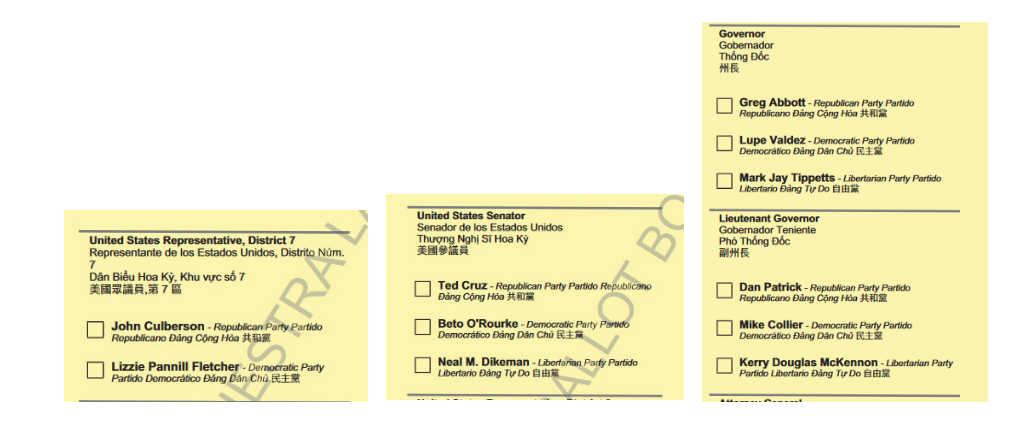
Figure 6: Sample Ballot Entries for Harris County, Texas
Authorization to Vote
As shown in Figure 7, a person may be a an applicant for one or more authorizations to vote in an election. This authorization to vote must be based on that person’s voter registration..
Business Rule: Each person who is an applicant for an authorization to vote is also required to be the holder of one voter registration that has a valid “Approval Date” and is the basis for that authorization to vote.
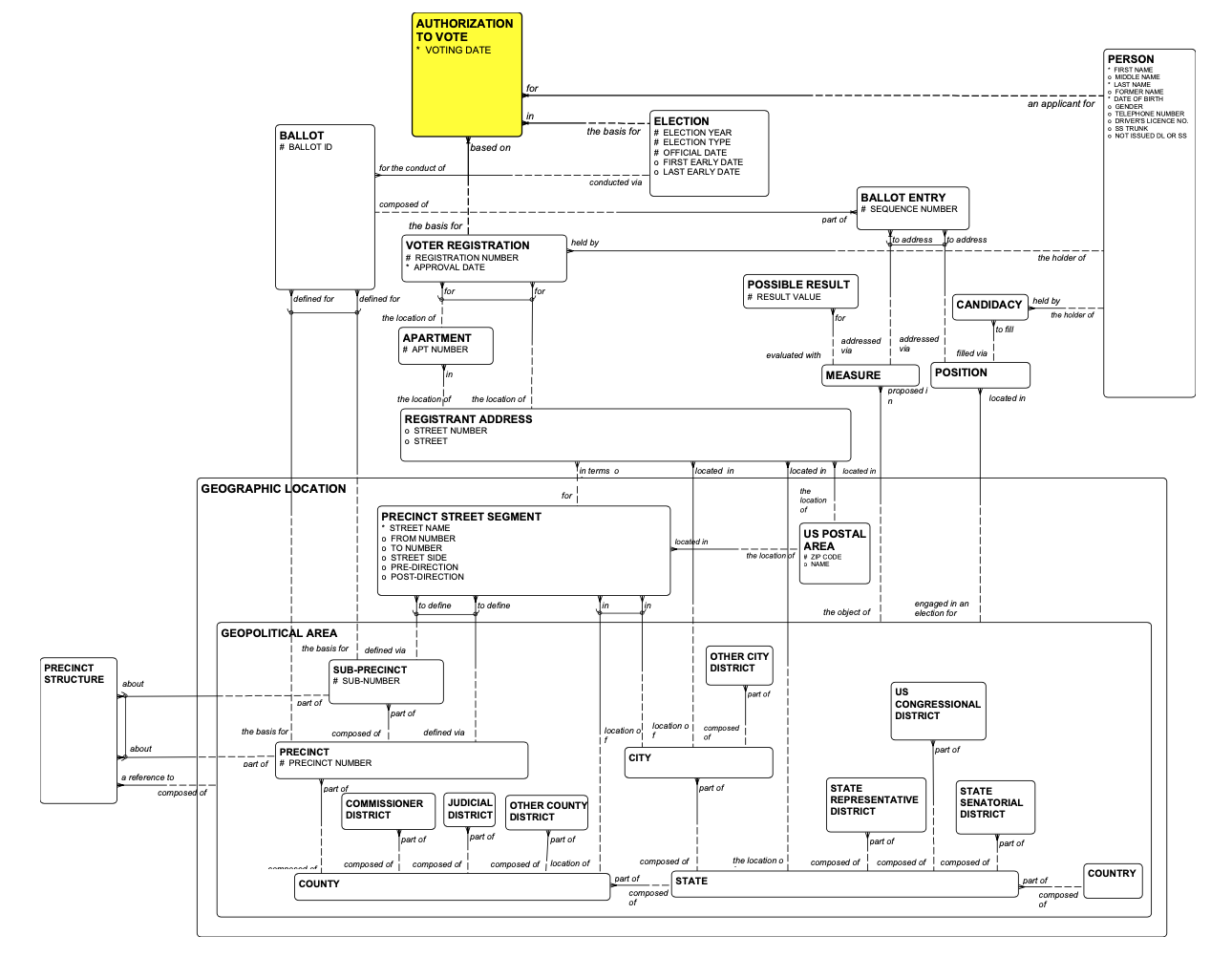
Figure 7: Authorizations to vote
The Vote Itself
That voter then will be presented with the ballot that is appropriate for h’ precinct and that election. That is, each authorization to vote in an election, (validated as the presence of an identified person and h’ voter registration) can now be for one and only one voting session, which in turn must be composed of one or more actual votes. (See Figure 8.) Each vote then, must be either for one candidacy to fill a position, or for one write-in candidate, or for one possible result from a measure.
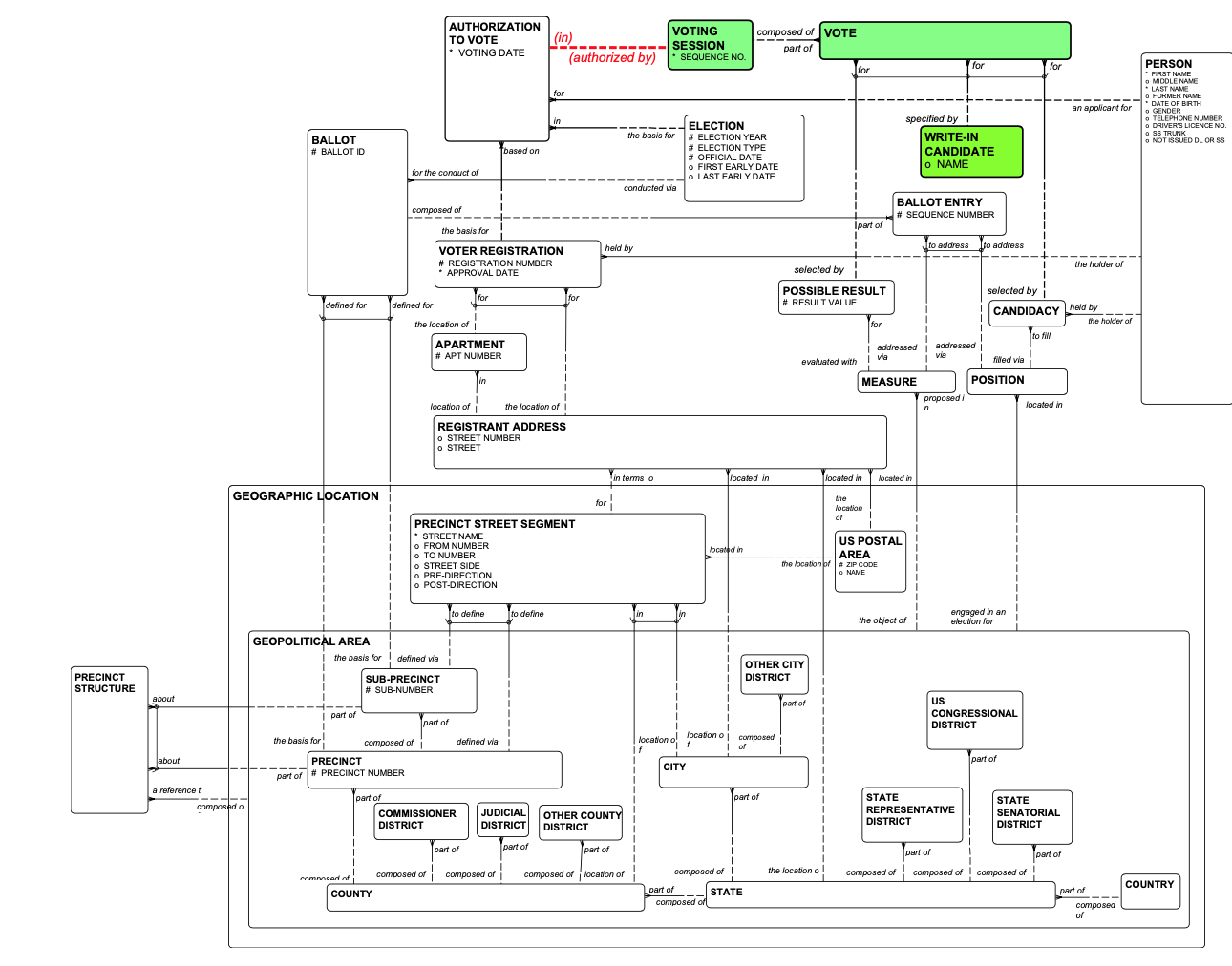
Figure 8: The Vote
Business Rules:
-
The “Voting Date” of an authorization to vote must be either equal to the “Official Date”, or on or after the “First Early Voting Date”, or on or before the “Last Early Voting Date”.
-
While it is true that each voting session must be authorized by one and only one authorization to vote, the link between this authorization to vote and the voting session must be outside any information system. That is, there may be no physical connection between these two sets of data. The relationship between the authorization to vote and the voting session must be kept anonymous.
Specifically, the voting process in Harris County, Texas, begins with one Election Clerk determining that the person who is an applicant is who ‘e says ‘e is, and is identified as the holder of a valid voter registration in the precinct where the election is being conducted. With this, the clerk has created an authorization to vote. This is done via a small computer linked to the registration database. A second Election Clerk then uses the booth controller equipment in an unconnected system (the “Judge’s Booth Controller”) to generates a sequence number to identify the voting session. In the process, this sequence number is printed on a piece of paper, which is given to the voter. At the booth, the voter enters the sequence number into the voting machine, and the set of h’ votes are now all connected to that voting session.
There is no connection between the registration database and the election voting equipment.
This was a two part series, describing the structure of the voting process in Harris County, Texas.
The first article provided the context:
- Geopolitical Areas – The way a bounded neighborhood precinct overlays various voting districts, including congressional and state representative districts, among others.
- Precinct Structures – How a precinct is related to all of its overlapping districts
- Precincts and Streets – How a prospective voter’s address may be found in a particular precinct.
The second article filled in the details:
- Voter Registrations – How each potential voter is recorded and connected to a precinct
- Candidacies – How a candidate for an office (or a ballot measure) may be shown relative to the district ‘he or she (or it) represents.
- Elections – How ballots are selectively defined for each precinct.
- Voting Sessions – How a vote may be recorded for each candidate (or ballot measure).
